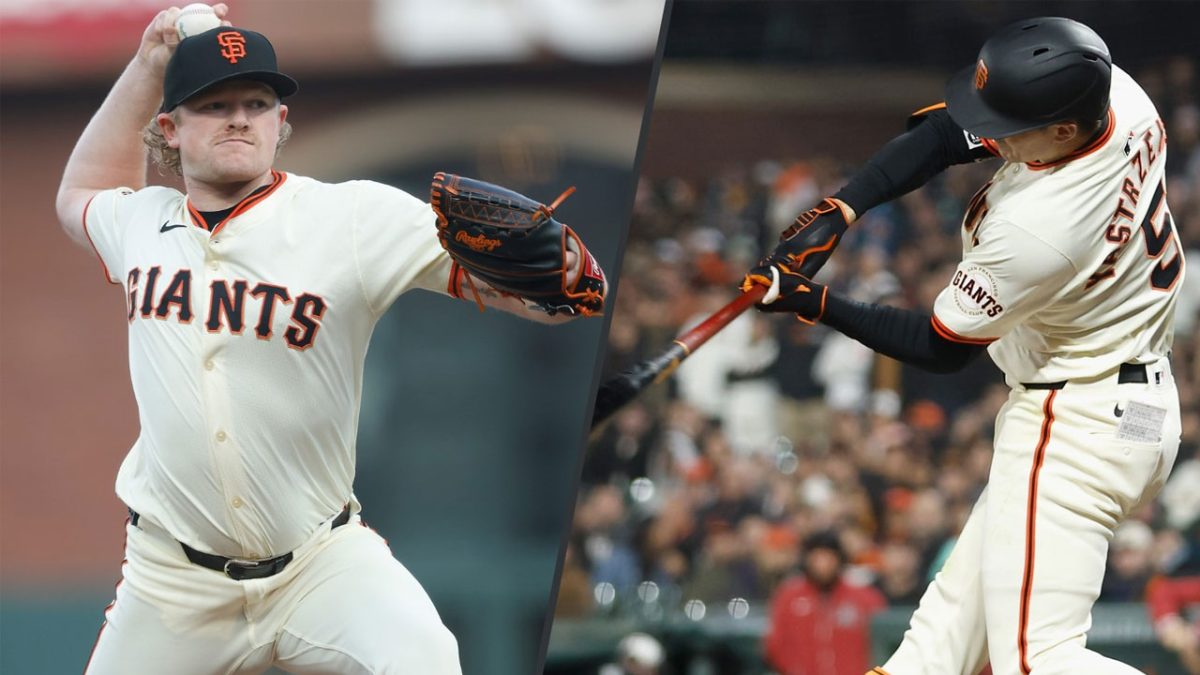What to Know
- Giants fans are back at Oracle Park this season, and so are the seagulls that arrive after every game to eat the food they leave behind
- The birds often begin circling the ballpark while the game is still going on, and can become aggressive if it goes into extra innings
- Baseball season coincides with breeding season for gulls, and experts say that could play a big role in their feeding behavior
As the first notes of the national anthem rang out from Oracle Park one evening in May, a lone seagull glided past the waving "Giants" flag on the ballpark's northernmost turret, announcing its presence with a jarring squawk.
The birds are well known to Giants fans — especially those who sit in the left field bleachers, just steps from the ballpark's famed food court, with a clear view of the sky. The gulls begin assembling toward the end of every game, eagerly waiting to chow down on hot dogs, garlic fries and nachos.
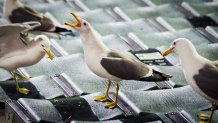
Get a weekly recap of the latest San Francisco Bay Area housing news. Sign up for NBC Bay Area’s Housing Deconstructed newsletter.
"They're vultures," remarked one fan, clearly not concerned that gulls and vultures are hardly related.
"They're just rats with wings," said another, who could've just as easily been talking about pigeons.
Here Since the Beginning
Sports
Whatever you call them, the birds showed up on the very first day the Giants played at the waterfront venue that opened as Pac Bell Park in 2000, and they've been coming to games ever since.
"They're not here when we don't play," said Giants Chief Venue Officer Jorge Costa. "It's like they know the damn schedule!"

Costa, who's worked for the Giants since 1989, found himself in a game of cat-and-mouse with the gulls almost as soon as the ballpark opened. That game has gone on for more than two decades, with no end in sight.
"I found chicken bones on the field, and I'm thinking: How are these chicken bones getting on the field? Are people throwing them?" Costa recalled.
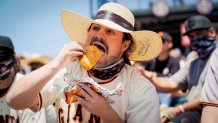
He got his answer during a 2015 game between the Giants and the Arizona Diamondbacks that had gone deep into extra innings. Television audiences watched the slow-motion replay over and over, as a half-eaten chicken tender fell from the sky and landed squarely on the pitcher's mound.
"They were dropping them. They'd eat them or fight over them, and then they'd drop them. So that solved that mystery," Costa said.
Over the years, he added, he's come across plenty of other food items left in strange places throughout the ballpark, and each caper has ultimately wound up with the birds as the culprits.
Blame It On Nature
It turns out science has a good explanation for this: through a quirk of nature's calendar, the start of baseball season happens to coincide almost exactly with the start of breeding season for several types of gulls that nest in the Bay Area.

"Some studies have actually shown that gulls will increase the time they spend feeding on human food ... during their breeding season," said Max Tarjan, science director for the San Francisco Bay Bird Observatory.
That includes the large, pink-legged western gull, which nests on Alcatraz and the Farallon Islands, and the smaller, yellow-legged California gull, which nests farther inland, in and around the Bay.
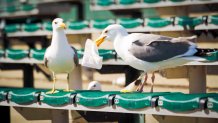
"Back in 1980, there were no (nesting California) gulls," in San Francisco Bay, said Gabbie Burns, lead biologist for the San Francisco Bay Bird Observatory. "It has exploded to a recent peak of around 55,000 breeding birds."
The explosive growth in the population, Burns said, is almost entirely attributable to humans and their leftover food. The observatory keeps tabs on the population by counting the birds and their eggs every spring, often kayaking out to small islands in ponds and waterways.
"Their populations are just doing incredibly well," said Josh Scullen, a senior biologist with the observatory, as he counted birds in the Bay's largest nesting colony. "The gulls have just really adapted well to living in an urban environment."
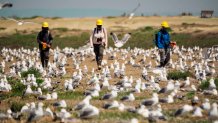
Walking up and down the the long, flat island in a Palo Alto creek where more than 10,000 birds come to nest every spring, Burns came across a shining example.
"One of the nests we saw had some recently hatched chicks in it, and also a little pile of French fries that their parents had left for them," she said, and showed a picture as proof.
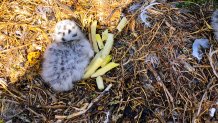
Creatures of Habit
For Giants fans, though, the mystery has remained: How do the birds know where the fries are, and when to find them?
"I would just love to do an experiment where we tracked a couple of birds," Costa said.
As it turns out, that experiment is already underway. Scott Shaffer, a marine ecologist who's a professor at San Jose State University, travels out to the Farallon Islands every spring to put tiny GPS tracking tags on a handful of western gulls. The birds, which can recognize human faces, wear the tags for up to two weeks before Shaffer sneaks up on them in disguise to carefully remove the trackers and download the data.
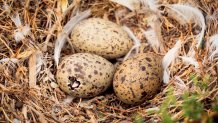
"Part of my research is to understand where they go," when they leave their nests in search of food, Shaffer said.
In past years, Shaffer has learned that many gulls have a daily dining routine of sorts: individual birds will find a good food source, learn the best times to visit it, and return over and over again. That includes a bird that would repeatedly commute from its island digs into one of San Francisco's densest neighborhoods.
"This particular bird ... flew from Alcatraz into what we think is a dumpster behind a delicatessen in the Tenderloin," he said. "And it did that I think five different times."

Another bird made headlines in local newspapers for its elaborate dinner ritual: it jumped aboard a garbage truck and hitchhiked from San Francisco to a compost facility in the East Bay.
"That bird actually did it twice — down the freeway, crossed over the Bay Bridge, stayed overnight, and then it flew all the way back to its nest (on the Farallon Islands) the next day," Shaffer said.
Shaffer said he's trying hard to catch a bird in the act of visiting the ballpark — even coordinating his tracking efforts with the Giants' schedule. Based on his research up to this point, he suspects it's the same birds over and over again. He added it's also likely that the birds frequenting the ballpark this season are the same ones that used to visit it before their year-long absence during the coronavirus pandemic, when the Giants played in front of empty stands.
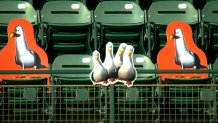
Long Live the Birds
Though a GPS-tracked bird has yet to visit the ballpark, Giants fans have indeed spotted birds wearing identification bands around their tiny legs. Those bands give researchers valuable information about how long the birds live, and how their nesting patterns shift over time. They've learned gulls can live 20 years or more, and usually return to the same nesting spot with the same partner year after year.
"Some of the birds that we've re-sighted in past years have been almost 40 years old," Scullen said.
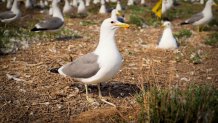
That means it's almost certain that there are birds alive today that saw the Giants play at Candlestick Park (which was right next to a Recology compost facility they might have also enjoyed). It's even possible some were alive when Willie Mays was inducted into the Hall of Fame.
Because they live so long, and continue breeding for most of their lives, Tarjan said it's not surprising that their population increased exponentially until 2013 — and she said it's noteworthy that the year their numbers began leveling off was the same year both the Giants and Recology began taking measures to manage their behavior.
Everybody Clap Your Hands
Costa said it feels like the Giants have tried everything to prevent a repeat of the now-infamous chicken tender incident — and to spare fans in the bleachers from getting gooey "presents" dropped on them by agitated birds. (Tarjan says they do it on purpose, by the way — it's a defensive weapon against predators.)
The problems seem to occur mostly during extra innings, especially at night games. Costa's working theory is that the birds have an internal clock of sorts, and know about what time a game is "supposed" to end. Shaffer's research supports that theory. Tarjan adds that gulls are daytime feeders, and may be anxious to get back to their nests soon after dark. Either way, it means the Giants sometimes have to take measures to encourage the birds to wait their turn.
Some of the team's efforts haven't gone so well — like the season they began playing a realistic recording of a gull in distress over the ballpark loudspeakers.
"That scared the birds," he said. "And children. And adults."
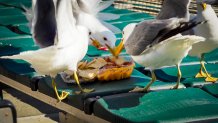
Then there was the season they brought in a young red-tailed hawk named Bruce Lee.
"He scared the birds — the crows and the pigeons," Costa said. "The gulls, not so much."
But though the gulls do love the ballpark's notorious nachos and fan favorite Cha-Cha Bowls, the Giants have discovered the birds utterly hate the song known as the "Cha-Cha Slide."
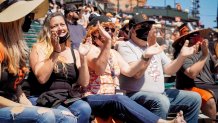
"It goes literally like, 'Everybody clap your hands,'" Costa said, and demonstrated by clapping his hands eleven times in rhythm.
Getting fans to clap along with the song is a great way to get the gulls to slide right out of the ballpark — at least for a little while, he said.
Generations of Memories
Costa says his most important job at Oracle Park is ensuring that families who come to a Giants game get to experience the kind of timeless memories that make baseball special from one generation to the next. He was probably talking about human families — but then again, he didn't specify.
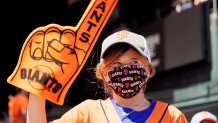
Shaffer points out that sometime in September or October — when the Giants might be laser-focused on the race for the National League pennant — another kind of family might be showing up at Oracle Park.
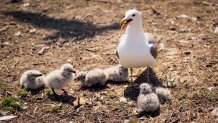
"When the chicks are big enough to fly," Shaffer said, "A family of gulls might actually head to the ballpark and feast on what's there with their young fledgling chick."
Do the young birds then develop a taste for garlic fries that stays with them for life? Shaffer and Tarjan said they hope that one day soon, they'll have the answer.

